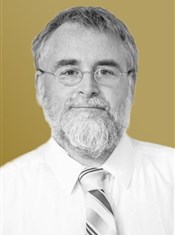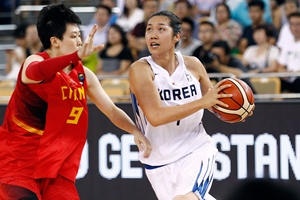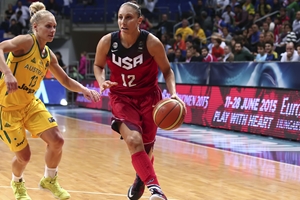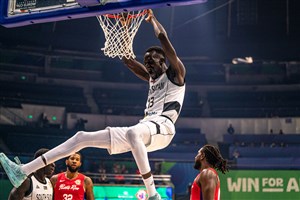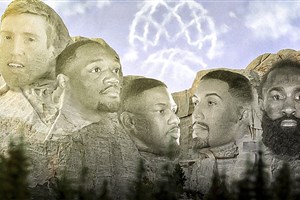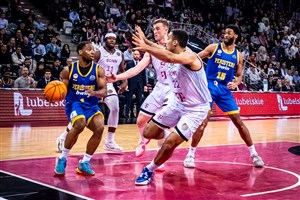
Koenig providing inspiration for improving Native American basketball players
REGENSBURG (David Hein's Eye on the Future) - Bronson Koenig is a hero in Wisconsin, hitting a three-pointer at the buzzer to send the Wisconsin Badgers to the NCAA Sweet 16. But he is also becoming a legend in Native American basketball history.
The junior is already the most successful Native American basketball player in history, and Koenig is two victories from reaching the NCAA Final Four for the third straight year. He was the first men's Native American basketball player to play and score in an NCAA title game last April, losing to Duke in the final.
After knocking down the game-winner over Xavier, Koenig, a member of the Ho-Chunk tribal nation, made sure to share the moment with his fellow Native Americans.
That was for all my Natives out there, & my team, & of course the true fans out there!! Thank you.
— Bronson Koenig (@BronsonK_24) March 21, 2016
According to the US census in 2010, there were about 5.2 million American Indian and Alaska Natives among the some 560 tribal nations across the United States. Each tribal nation - the biggest two being Navajo and Cherokee - has its own culture, customs, beliefs and treaties with the US government.
More and more, basketball is becoming a major part of everyday life among Native American. And that can be seen on the courts of more of the bigger collegiate programs in the United States.
In addition to Koenig, other Native Americans to play at a high level in college include Ron Baker of Wichita State and Kentucky’s Derek Willis - both of whom have also played at an NCAA Final Four.
Native Americans also had a major highlight to celebrate in women’s college basketball in 2013 as the sisters Shoni and Jude Schimmel of the Confederated Tribes of the Umatilla helped Louisville to the 2013 NCAA championship game, losing to powerhouse Connecticut. They were the first Native American women to play in an NCAA women’s Final Four.
After leaving Louisville, Shoni Schimmel was a 2014 WNBA Draft first round pick by the Atlanta Dream and also represented the United States at the 2013 Universiade in Kazan.
Koenig's shot reminded many in the Native American community of the Schimmel sisters, according to Brent Cahwee, the editor of NDNSports.com - a website which covers Native American athletes.
"For him to hit that shot it brought back all those memories that everyone had with Shoni and Jude Schimmel. It was that big of an impact," Cahwee said.
Hundreds of thousands of Native Americans posted tweets and messages on Facebook about how proud they were of him and how proud it made them feel. - Cahwee
"It is important when someone like Bronson Koenig gets on Twitter and says 'That's for my Natives' because now these Native youth have something to aspire to. They become a beacon that Native youth can look to as something they want to achieve," Cahwee added.
Bronson Koenig on Native Mascots: 'People Think It's Ok to Make Fun of Us' https://t.co/2nZ7pyLayC via @IndianCountry
— Crystal EchoHawk (@CrystalEchoHawk) March 24, 2016
Koenig and the others are the leaders of the Native American basketball community but other Natives have reached great heights in other sports.
Jacoby Ellsbury and Joba Chamberlain are both baseball World Series champions while Sam Bradford is a high level quarterback in the NFL (National Football League) in the US.
Basketball fans should get used to hearing more about Native Americans in the collegiate landscape, according to Cahwee, who says the past disadvantage of Natives not being seen by college recruiters is starting to break down.
One of the major avenues that Natives are getting more attention is the annual NABI (Native American Basketball Invitational) Tournament in Phoenix, where 64 men’s and 64 women’s high school teams with 100 percent Native Americans compete over six days with the finals played at the Talking Stick Resort Arena, home of the Phoenix Suns.
More college recruiters are coming to NABI and seeing the improving level of Native Americans, few of whom get the opportunity to play on the summer AAU circuit.
Cahwee mentioned three of the top young players in Native high school basketball. Lindy Waters III of the Kiowa and Cherokee tribes who plays out of Norman, Oklahoma will be attending Oklahoma State next season while junior David Wingett is an intriguing lefty wing player from Winnebago, Nebraska, who is getting a lot of major college interest now.
And 2000-born Kamaka Hepa of Inupiaq in Alaska is already drawing major interest as a sophomore.
Waters, Wingett and Hepa may make their mark on the collegiate game in the coming years, following in the footsteps of Natives who played ahead of them, such as Koenig, who still has the rest of this NCAA Tournament and his senior year with Wisconsin.
Koenig has set the bar high for all basketball players with back-to-back NCAA Final Four appearances. But he’s taken on even more of a leadership role this season with many of Wisconsin’s top players graduating after last season’s title game.
And Koenig is proving to be an inspiration for Native Americans around the US.
David Hein
FIBA
FIBA's columnists write on a wide range of topics relating to basketball that are of interest to them. The opinions they express are their own and in no way reflect those of FIBA.
FIBA takes no responsibility and gives no guarantees, warranties or representations, implied or otherwise, for the content or accuracy of the content and opinion expressed in the above article.
